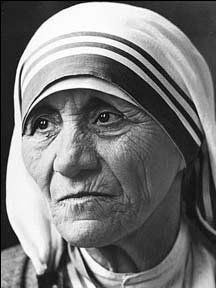Mother Teresa's father was poisoned for his political beliefs when she was seven. She was raised by her mother, who invited beggars knocking at the door to dine with them. "Never eat a single mouthful unless you are sharing it with others," her mother said. "Some of them are our relations, but all of them are our people."
As a child she read the lives of the saints, and kept a map of the world on her wall, where she marked sites of missionary work. The Sacred Heart choir, in which she sang, made a pilgrimage to the Church of the Black Madonna, where she felt called to religious life.
At 18 she left for a convent in Ireland. The sisters found her "very small, quiet and shy." The next year she sailed to Calcutta, staying in a convent of the Sisters of Loreto. She took the name Teresa in honor of St. Thérèse of Lisieux, patron saint of missionaries.
On the train to Darjeeling, headed for a retreat in the Himalayan foothills, she felt called to serve the poor, bringing dignity to the lives of the dying, street children, and vagabonds. She thought of Christ on the cross saying, "I thirst," and felt this had a special meaning for her, that he thirsted for the neglected to receive consolation. She wanted to accomplish this for him.
She left her quiet convent for the worst streets of Calcutta. Instead of a nun's habit, she wore a simple sari. Her first day in the slums she found a man dying alone in the street and gave him water. He was "so strangely grateful," she wrote. She taught poor children to read by writing in the dirt with a stick, then followed them home to help their families.
Her former students began to join her. They founded a home for the gravely ill called "Home of the Pure Heart," where the dying were soothed and given last rites according to their beliefs. She said, "A beautiful death is for people who lived like animals to die like angels--loved and wanted." She founded a hospice for those suffering from leprosy, "City of Peace," and an orphanage, "Children's Home of the Immaculate Heart."
When she received the Nobel Prize she said, "It is not enough for us to say, 'I love God, but I do not love my neighbor,'" and declined the banquet in her honor, requesting the cost be donated to the poor.
Despite the apparent simplicity and fluidity of her life - love of God translating directly into a life of service to the poor - Mother Teresa had a dark secret. For fifty years she silently endured the fear God had abandoned her. She no longer sensed his presence in her life, feeling her soul was an "ice block."
"When I try to raise my thoughts to Heaven-there is such convicting emptiness that those very thoughts return like sharp knives & hurt my very soul," she wrote. "There is such terrible darkness within me, as if everything was dead. It has been like this more or less from the time I started 'the work.'" "Tell me, Father, why is there so much pain and darkness in my soul?" she asked.
Mother Teresa was not the first saint to experience what to St. John of the Cross was a "dark night of the soul," to St. Ignatius Loyola, a "spiritual desolation," and to St. Thérèse of Lisieux, a "night of nothingness." When theologian Joseph Neuner said it might help her understand the abandonment felt by the poor she served, Mother Teresa wrote him, "I have come to love the darkness."
Jesuit priest James Martin wrote that decades of her letters documenting the struggle with this darkness could be as significant after her death as her service to the poor was during her life, lending consolation to others who feel abandoned by God. "If I ever become a Saint--I will surely be one of 'darkness,'" wrote Mother Teresa. "I will continually be absent from Heaven--to light the light of those in darkness on earth."

